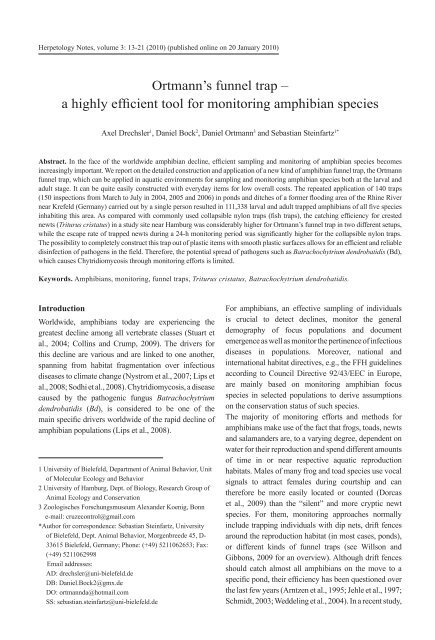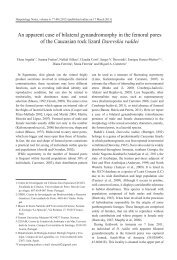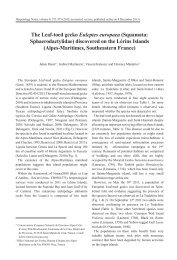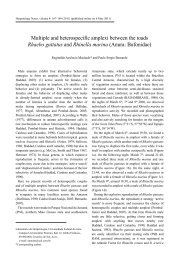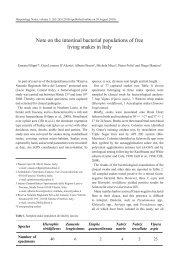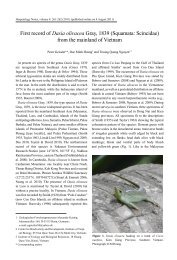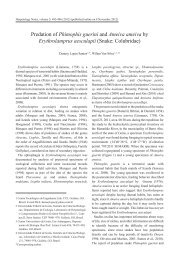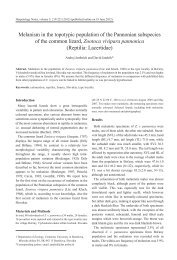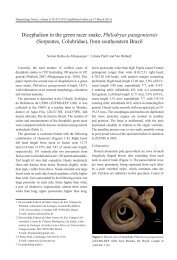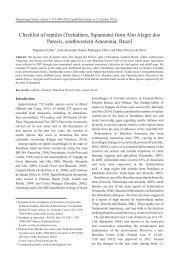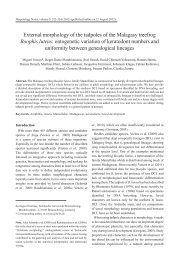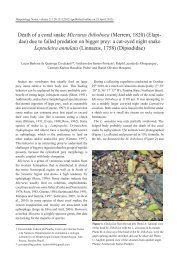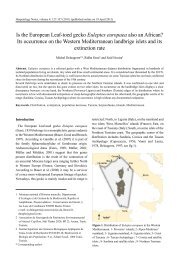Ortmann's funnel trap - Universität Bielefeld
Ortmann's funnel trap - Universität Bielefeld
Ortmann's funnel trap - Universität Bielefeld
You also want an ePaper? Increase the reach of your titles
YUMPU automatically turns print PDFs into web optimized ePapers that Google loves.
Herpetology Notes, volume 3: 13-21 (2010) (published online on 20 January 2010)<br />
Ortmann’s <strong>funnel</strong> <strong>trap</strong> –<br />
a highly efficient tool for monitoring amphibian species<br />
Introduction<br />
Axel Drechsler 1 , Daniel Bock 2 , Daniel Ortmann 3 and Sebastian Steinfartz 1*<br />
Abstract. In the face of the worldwide amphibian decline, efficient sampling and monitoring of amphibian species becomes<br />
increasingly important. We report on the detailed construction and application of a new kind of amphibian <strong>funnel</strong> <strong>trap</strong>, the Ortmann<br />
<strong>funnel</strong> <strong>trap</strong>, which can be applied in aquatic environments for sampling and monitoring amphibian species both at the larval and<br />
adult stage. It can be quite easily constructed with everyday items for low overall costs. The repeated application of 140 <strong>trap</strong>s<br />
(150 inspections from March to July in 2004, 2005 and 2006) in ponds and ditches of a former flooding area of the Rhine River<br />
near Krefeld (Germany) carried out by a single person resulted in 111,338 larval and adult <strong>trap</strong>ped amphibians of all five species<br />
inhabiting this area. As compared with commonly used collapsible nylon <strong>trap</strong>s (fish <strong>trap</strong>s), the catching efficiency for crested<br />
newts (Triturus cristatus) in a study site near Hamburg was considerably higher for Ortmann’s <strong>funnel</strong> <strong>trap</strong> in two different setups,<br />
while the escape rate of <strong>trap</strong>ped newts during a 24-h monitoring period was significantly higher for the collapsible nylon <strong>trap</strong>s.<br />
The possibility to completely construct this <strong>trap</strong> out of plastic items with smooth plastic surfaces allows for an efficient and reliable<br />
disinfection of pathogens in the field. Therefore, the potential spread of pathogens such as Batrachochytrium dendrobatidis (Bd),<br />
which causes Chytridiomycosis through monitoring efforts is limited.<br />
Keywords. Amphibians, monitoring, <strong>funnel</strong> <strong>trap</strong>s, Triturus cristatus, Batrachochytrium dendrobatidis.<br />
Worldwide, amphibians today are experiencing the<br />
greatest decline among all vertebrate classes (Stuart et<br />
al., 2004; Collins and Crump, 2009). The drivers for<br />
this decline are various and are linked to one another,<br />
spanning from habitat fragmentation over infectious<br />
diseases to climate change (Nystrom et al., 2007; Lips et<br />
al., 2008; Sodhi et al., 2008). Chytridiomycosis, a disease<br />
caused by the pathogenic fungus Batrachochytrium<br />
dendrobatidis (Bd), is considered to be one of the<br />
main specific drivers worldwide of the rapid decline of<br />
amphibian populations (Lips et al., 2008).<br />
1 University of <strong>Bielefeld</strong>, Department of Animal Behavior, Unit<br />
of Molecular Ecology and Behavior<br />
2 University of Hamburg, Dept. of Biology, Research Group of<br />
Animal Ecology and Conservation<br />
3 Zoologisches Forschungsmuseum Alexander Koenig, Bonn<br />
e-mail: cruzecontrol@gmail.com<br />
*Author for correspondence: Sebastian Steinfartz, University<br />
of <strong>Bielefeld</strong>, Dept. Animal Behavior, Morgenbreede 45, D-<br />
33615 <strong>Bielefeld</strong>, Germany; Phone: (+49) 5211062653; Fax:<br />
(+49) 5211062998<br />
Email addresses:<br />
AD: drechsler@uni-bielefeld.de<br />
DB: Daniel.Bock2@gmx.de<br />
DO: ortmannda@hotmail.com<br />
SS: sebastian.steinfartz@uni-bielefeld.de<br />
For amphibians, an effective sampling of individuals<br />
is crucial to detect declines, monitor the general<br />
demography of focus populations and document<br />
emergence as well as monitor the pertinence of infectious<br />
diseases in populations. Moreover, national and<br />
international habitat directives, e.g., the FFH guidelines<br />
according to Council Directive 92/43/EEC in Europe,<br />
are mainly based on monitoring amphibian focus<br />
species in selected populations to derive assumptions<br />
on the conservation status of such species.<br />
The majority of monitoring efforts and methods for<br />
amphibians make use of the fact that frogs, toads, newts<br />
and salamanders are, to a varying degree, dependent on<br />
water for their reproduction and spend different amounts<br />
of time in or near respective aquatic reproduction<br />
habitats. Males of many frog and toad species use vocal<br />
signals to attract females during courtship and can<br />
therefore be more easily located or counted (Dorcas<br />
et al., 2009) than the “silent” and more cryptic newt<br />
species. For them, monitoring approaches normally<br />
include <strong>trap</strong>ping individuals with dip nets, drift fences<br />
around the reproduction habitat (in most cases, ponds),<br />
or different kinds of <strong>funnel</strong> <strong>trap</strong>s (see Willson and<br />
Gibbons, 2009 for an overview). Although drift fences<br />
should catch almost all amphibians on the move to a<br />
specific pond, their efficiency has been questioned over<br />
the last few years (Arntzen et al., 1995; Jehle et al., 1997;<br />
Schmidt, 2003; Weddeling et al., 2004). In a recent study,
14<br />
Axel Drechsler et al.<br />
Figure 1. Different views on Ortmann’s <strong>funnel</strong> <strong>trap</strong>; picture of used collapsible nylon <strong>trap</strong> and study sites in Krefeld. (A) View<br />
inside of Ortmann’s <strong>funnel</strong> <strong>trap</strong>: four half-cut inverted plastic bottles are inserted into the bucket. Swimmers (two foamed plastic<br />
tubes) are fixed with an elastic plastic string through openings in the bucket. (B) Lateral view of Ortmann’s <strong>funnel</strong> <strong>trap</strong>. (C)<br />
Ortmann’s <strong>funnel</strong> <strong>trap</strong> built with two tightly closed 0.33-l plastic bottles instead of the foamed plastic tubes at the upper part of the<br />
bucket wall. (D) Exposed <strong>trap</strong> in a pond. (E) Top view of Ortmann’s <strong>funnel</strong> <strong>trap</strong>. Please notice that the lid has to provide enough<br />
holes to allow oxygen transfer during exposure in the field. (F) Schematic illustration of a collapsible nylon <strong>trap</strong> used for the<br />
comparative study. (G) Large pond and (H) ditch as typically sampled for amphibians with Ortmann’s <strong>funnel</strong> <strong>trap</strong> for the study<br />
part in Krefeld (Germany).
An efficient <strong>funnel</strong> <strong>trap</strong> for amphibian monitoring 15<br />
Ortmann et al. (2005) showed that <strong>funnel</strong> <strong>trap</strong>s clearly<br />
out-compete drift fences over short periods of time (14<br />
days) as well in the long term (up to three years) when<br />
monitoring crested newts (Triturus cristatus) in a Middle<br />
European habitat (Baker, 1999). Indeed, <strong>funnel</strong> <strong>trap</strong>s<br />
have been shown to effectively catch different species<br />
of amphibians, and especially newts during their aquatic<br />
reproduction period (Fronzuto et al., 2000; Mölle et al.,<br />
1998; Tucker, 1995; Wilson et al., 2002).<br />
In this study, we present data for a new type of amphibian<br />
<strong>funnel</strong> <strong>trap</strong>, the Ortmann <strong>funnel</strong> <strong>trap</strong>, which is designed<br />
to catch newts and other aquatic amphibians. We<br />
provide a detailed description of how to construct this<br />
kind of <strong>trap</strong> and show with our data that the <strong>trap</strong>ping of<br />
aquatic amphibians is highly efficient with this new <strong>trap</strong><br />
type. Especially newts, in comparison to the commonlyused<br />
collapsible nylon <strong>trap</strong> (also called the fish <strong>trap</strong>),<br />
can be efficiently sampled. The Ortmann <strong>funnel</strong> <strong>trap</strong> can<br />
be easily constructed for a low overall price, with items<br />
available almost everywhere around the globe. Most<br />
importantly, as one variant of this <strong>trap</strong>, it is completely<br />
designed out of plastic items that have a smooth surface,<br />
and it can be easily and exhaustively disinfected, thereby<br />
limiting the possibility of spreading pathogens (e.g., Bd)<br />
through the monitoring efforts (Johnson et al., 2003;<br />
Garner et al., 2009).<br />
Materials and Methods<br />
Design and construction of the Ortmann <strong>funnel</strong> <strong>trap</strong><br />
Basically, the Ortmann <strong>funnel</strong> <strong>trap</strong> is a further development of the<br />
single inverted bottle principle as designed and used by Griffith<br />
(1985). The significant advances of our <strong>trap</strong> are the multiplication<br />
of <strong>funnel</strong> openings while providing more space within a single<br />
<strong>trap</strong> and the ability to swim, so that caught amphibians do not<br />
drown (see Fig. 1A-D). Essentially, the Ortmann <strong>funnel</strong> <strong>trap</strong> is an<br />
empty 10-l or 15-l paint bucket with four to five distinct openings<br />
in which half-cut inverted 1.5l plastic bottles are inserted and act<br />
as <strong>funnel</strong>s. Counter-sunk in the respective habitat (e.g., a pond),<br />
aquatic amphibians (adults and larvae) can easily enter the bucket<br />
through the <strong>funnel</strong>s, but have difficulties leaving it again.<br />
In the following, we will describe the construction of the <strong>funnel</strong><br />
<strong>trap</strong> in detail. The bottom of the bucket as well as the lower part<br />
of the bucket walls are perforated with little holes (smaller than 4<br />
mm in diameter to avoid injuries to the larvae), as shown in Fig.<br />
1A and Fig 1B. Holes in the size of a half-cut 1-l or 1.5-l bottle are<br />
inserted into the wall of the paint bucket at different positions, as<br />
shown in Fig. 1B, so that, in each hole, one inverted bottle can adequately<br />
be inserted. Inserted bottles are then fixed with underwater-stable<br />
glue at the contact zone of the bottle and at the wall of<br />
the bucket. It is important that contact zones are absolutely clean<br />
and fat-free before gluing them. Additionally, care has to be taken<br />
that only underwater-stable glue is used (e.g., Soudal FixAll clas-<br />
sic), as otherwise bottles will easily fall off. In order that the <strong>trap</strong><br />
can swim so that caught amphibians are able to gasp for breath,<br />
two foamed plastic tubes are placed at the upper part of the bucket<br />
wall fixed with a robust plastic string (see Fig. 1A-B). Since foam<br />
offers a complex surface that might be difficult to disinfect, alternatively,<br />
two tightly closed 0.33-l plastic bottles are installed<br />
instead of the foamed plastic tubes at the upper part of the bucket<br />
wall (see Fig. 1C-D). iv.). The accompanying lid of the bucket is<br />
riddled with small holes to allow for oxygen exchange (see Fig.<br />
1E), and it is used as a cover for the bucket during exposure.<br />
The assembled <strong>trap</strong> can now be used but should be fixed with the<br />
help of a plastic string fixed by a tent peg to avoid uncontrolled<br />
drifting. According to our experience, the use of plastic strings<br />
is strongly recommended since other material has been gnawed<br />
by rodents and/or has a higher risk of rotting if <strong>trap</strong>s are used<br />
continuously.<br />
Application of Ortmann’s <strong>funnel</strong> <strong>trap</strong> under<br />
natural conditions<br />
Altogether, 140 <strong>funnel</strong> <strong>trap</strong>s were used during 150 inspections,<br />
each from March to July in 2004, 2005 and 2006 to monitor 28<br />
stagnant water bodies for crested newts in a former flooding area<br />
of the Rhine River near the town of Krefeld, Germany (coordinates:<br />
51°19`5`` N, 6°39`17`` E). Inspected water bodies ranged<br />
from small to large ponds (Fig. 1G), but also included ditches<br />
(Fig. 1H). Depending on the size of the respective pond/ditch,<br />
four to 38 <strong>trap</strong>s were applied per inspection and <strong>trap</strong>s were tried<br />
to be distributed equal distances from each other and across the<br />
respective body of water. On average, <strong>trap</strong>s were exposed for 48<br />
hours. Each individual was recorded regarding its species status<br />
and developmental state (i.e., larva or metamorphosed). After registration,<br />
all of the individuals were released directly into the<br />
water where they have been formerly caught.<br />
Comparing the efficiency of Ortmann’s <strong>funnel</strong> <strong>trap</strong><br />
with a collapsible nylon <strong>trap</strong><br />
In a recent study carried out in two distinct study areas in the east<br />
of Hamburg in Germany (53°37`16`` N, 10°11`36`` E; 53°28`34``<br />
N, 10°6`36`` E), we showed that collapsible nylon <strong>trap</strong>s (also<br />
commonly called fish <strong>trap</strong>s; see Fig. 1F) can be efficiently used<br />
for monitoring crested newts (Triturus cristatus; Bock et al.,<br />
2009). To test for the efficiency of the Ortmann’s <strong>funnel</strong> <strong>trap</strong>, we<br />
directly compared the catching success for crested newts of both<br />
<strong>trap</strong> types in a competitive setup and in a separate counter setup<br />
in the same study sites near Hamburg. In the competitive setup,<br />
Ortmann’s <strong>funnel</strong> <strong>trap</strong>s (four to five circular openings of about<br />
1 cm in radius) and collapsible nylon <strong>trap</strong>s with the size of 25 x<br />
25 x 43 cm (LxWxH) covered with 5-mm mesh-gauze and two<br />
round (2.75 cm radius) openings were simultaneously exposed<br />
for 24 hours in eight distinct ponds in April 2009. To test for the<br />
efficiency of a specific <strong>trap</strong> without the competing influence of<br />
the other <strong>trap</strong> type, we used each <strong>trap</strong> type at separate occasions in<br />
the same pond (counter setup). This way, we were able to test for<br />
the catching ability of the two different <strong>trap</strong> types in five counter<br />
setups in four different ponds. Supplementary Table 1 provides<br />
an overview of all of the catching occasions for the competitive<br />
and counter setups.
16<br />
The number of caught newts in the different setups and different<br />
<strong>trap</strong> types were broken down to determine the number of caught<br />
newts per <strong>trap</strong> type and the catching efficiency in relation to the<br />
size of the <strong>trap</strong> openings.<br />
Since <strong>trap</strong>ped individuals can potentially escape through the <strong>trap</strong><br />
openings in the case of collapsible nylon <strong>trap</strong>s (Bock et al., 2009),<br />
we compared the escape rate of <strong>trap</strong>ped individuals for both <strong>trap</strong><br />
types. Therefore, we monitored the presence of caught newts over<br />
a 24-hour period using the same approach as described in Bock<br />
et al. (2009). In short, <strong>trap</strong>s were controlled every two hours for<br />
newts, and every present newt was recorded by its individual ventral<br />
spot pattern and placed back in the <strong>trap</strong>. This way, it is possible<br />
to monitor the presence or escape of caught newts.<br />
Data analysis<br />
The program SPSS (Version 15.0.1 © SPSS Inc.) was used to<br />
perform Chi-squared and contingency tests for the nominal data.<br />
T-tests and ANOVA were used for the metric data. Before performing<br />
the T-tests, metric data were tested for a normal distribution<br />
using a Kolmogaroff-Smirnoff test that was also performed in<br />
SPSS.<br />
Results<br />
During a monitoring period of crested newts (Triturus<br />
cristatus) from 2004 to 2006 in the area of Krefeld<br />
(Germany), we caught 5,687 crested newts, 36,683<br />
common newts (Lissotriton vulgaris), 20,615 Alpine<br />
newts (Mesotriton alpestris), 40,692 common toads<br />
(Bufo bufo) and 7,661 pool frogs (Rana esculenta) by<br />
the application of the newly designed Ortmann <strong>funnel</strong><br />
<strong>trap</strong> (see Fig. 2). The observed mortality of amphibians<br />
caught inside the <strong>trap</strong>s was almost zero.<br />
Ortmann’s <strong>funnel</strong> <strong>trap</strong> showed a considerably higher<br />
catch-efficiency both in the number of caught newts<br />
per <strong>trap</strong> (Fig. 3a) and in the number of caught newts<br />
Axel Drechsler et al.<br />
Table 1. Results of competitive <strong>trap</strong> tests for crested newts in a study site near Hamburg (Germany). Specific number of caught<br />
newts per <strong>trap</strong> type during simultaneous application of collapsible nylon <strong>trap</strong> versus Ortmann’s <strong>funnel</strong> <strong>trap</strong> across eight distinct<br />
ponds (A-H). The date of inspection, identification of ponds (pond ID), corresponding values of the chi 2 test (chi 2 -value, P-value),<br />
total number of caught newts (N) and the number of caught newts per <strong>trap</strong> type are provided (n. c. = not calculated).<br />
Date Pond<br />
ID<br />
Chi 2 -value P N Crested newts in collapsible nylon<br />
<strong>trap</strong>/ Ortmann’s <strong>funnel</strong> <strong>trap</strong><br />
03.04.2009 A 9.846 0.002 26 5/21<br />
04.04.2009 B n. c. - 0 0/0<br />
07.04.2009 C 18.963 0.000 54 11/43<br />
08.04.2009 D n. c. - 13 0/13<br />
09.04.2009 E 3.769 0.052 13 3/10<br />
10.04.2009 F n. c. - 7 5/2<br />
15.04.2009 G 7.860 0.005 86 30/56<br />
17.04.2009 H 14.297 0.000 37 7/30<br />
in relation to the size of the <strong>funnel</strong> openings (Fig. 3b)<br />
when compared with collapsible nylon <strong>trap</strong>s in a study<br />
site near Hamburg carried out in 2009. In detail, if<br />
applied simultaneously in the same pond (i.e., under<br />
competitive conditions) considerably more newts were<br />
caught by Ortmann’s <strong>funnel</strong> <strong>trap</strong> than by the collapsible<br />
nylon <strong>trap</strong> in six out of eight independent pond-setups.<br />
In four cases (ponds A, C, G and H), this difference was<br />
highly significant (P
An efficient <strong>funnel</strong> <strong>trap</strong> for amphibian monitoring 17<br />
significantly longer than in the collapsible nylon <strong>trap</strong>s<br />
(ANOVA: F=15,800; df=2; p=0,000; n=112), thereby<br />
demonstrating that amphibians might escape more<br />
easily from the collapsible nylon <strong>trap</strong>s.<br />
Discussion<br />
In the face of world-wide declining amphibian<br />
populations, the effective sampling and <strong>trap</strong>ping of<br />
amphibians is a basic issue, as monitoring and sampling<br />
specific populations is normally the first step in<br />
addressing the reasons for and mechanisms of declining<br />
amphibian populations (Collins and Crump, 2009).<br />
During spring-field surveys of three consecutive years<br />
in a typical Middle European amphibian habitat, a single<br />
person (DO) was able to <strong>trap</strong> with Ortmann’s <strong>funnel</strong><br />
<strong>trap</strong> more than one hundred thousand larval and adult<br />
individuals of five distinct species (Figure 2; see also<br />
Ortmann, 2009). This catching success demonstrates<br />
the enormous power and efficiency of this <strong>trap</strong> type to<br />
monitor aquatic amphibian species. The first <strong>funnel</strong> <strong>trap</strong><br />
that was used for catching amphibians was designed<br />
by Griffith (1985) and represented a plastic bottle with<br />
an inverted bottleneck so that the newts could easily<br />
enter the bottle, but have difficulties in leaving it again.<br />
High catching-efficiency, low material costs and the<br />
simple engineering of this kind of <strong>trap</strong> was contrasted<br />
by its disadvantages, such as a short application period<br />
limited to a few hours (due to the potential drowning<br />
of amphibians) and the complicated discharging, i.e.,<br />
removal of individuals from the inside of the bottle.<br />
Other kinds of applied <strong>funnel</strong> <strong>trap</strong>s (Jahn and Jahn,<br />
1997 and Kupfer, 2001) were either complicated to<br />
handle and/or suffered from short exposure times (see<br />
Schlüpmann, 2006).<br />
By combining the high catch efficiency and low<br />
material costs of single <strong>funnel</strong> <strong>trap</strong>s while avoiding<br />
their disadvantages (short application periods and<br />
complicated discharging), Ortmann’s <strong>funnel</strong> <strong>trap</strong> is<br />
a major improved tool for sampling and monitoring<br />
aquatic amphibian species (Fig. 1A-E). As shown by our<br />
data, the Ortmann <strong>funnel</strong> <strong>trap</strong> is ideally suited to catch<br />
adult and larval newt species in ponds of quite different<br />
sizes (see Figures 1G-H). Larvae of anurans have been<br />
equally well <strong>trap</strong>ped, whereas the relative catching<br />
success of adult anurans is lower when compared to the<br />
larvae (see Fig. 2). When comparing the catch efficiency<br />
of crested newts under competitive (see Fig. 3 and Table<br />
Figure 2. Number of larval and adult individuals per amphibian species (in thousands) caught in the years 2004-2006 with Ortmann’s<br />
<strong>funnel</strong> <strong>trap</strong> in Krefeld (Germany). Values are shown for crested newts (Triturus cristatus), common newts (Lissotriton<br />
vulgaris), Alpine newts (Mesotriton alpestris), pool frogs (Rana esculenta) and common toads (Bufo bufo).
18<br />
1) or counter-conditions (see Table 2), Ortmann’s <strong>funnel</strong><br />
<strong>trap</strong> clearly out-competed the collapsible nylon <strong>trap</strong> that<br />
is commonly used for surveying aquatic amphibians.<br />
Although we have applied the Ortmann <strong>funnel</strong> <strong>trap</strong> only<br />
in stagnant waters, we think that it should also work<br />
well under running water conditions (e.g., streams) as<br />
long as the <strong>funnel</strong> openings are below the water level.<br />
To prevent the spread of Bd through monitoring and<br />
research efforts from one habitat to another, laboratory<br />
and field equipment should be efficiently disinfected<br />
(Johnson et al., 2003; Woodhams et al., 2003; Young<br />
et al., 2007; Pessier, 2008; Garner et al. 2009). As<br />
compared to other commonly applied <strong>trap</strong>s that all harbor<br />
complex and structured surfaces (e.g., nets or foam)<br />
that potentially complicate the efficient disinfection<br />
of <strong>trap</strong>s in the field, the possible construction of<br />
Ortmann’s <strong>funnel</strong> <strong>trap</strong> (completely out of plastic items<br />
with smooth surfaces) (see Fig. 1C) should enhance<br />
efficient disinfection. Since it has been shown that high<br />
concentrations of disinfectants (e.g., bleach) have a<br />
negative impact on tadpoles and zooplankton (Schmidt<br />
et al., 2009), this kind of construction could also favor<br />
the application of lower concentrations of disinfectants<br />
to eliminate pathogens.<br />
Conclusion<br />
We describe a new kind of efficient amphibian <strong>trap</strong> that<br />
can be constructed quite easily at low costs with items<br />
available all over the world. Applied to aquatic habitats,<br />
and allowing exposure of the <strong>trap</strong> openings under water,<br />
this item will catch larvae and adult amphibian species<br />
in high amounts. Its pure construction out of smooth<br />
plastic parts should allow for efficient and reliable<br />
disinfection in the field.<br />
Authors’ contributions<br />
DO invented the <strong>trap</strong>. SS designed the overall study.<br />
Field surveys in Krefeld were carried out by DO. DB<br />
performed the comparative study and the corresponding<br />
data analysis. AD, DB and SS drafted the manuscript. All<br />
of the authors read and approved the final manuscript.<br />
Acknowledgements<br />
Axel Drechsler et al.<br />
Table 2. Results of counter <strong>trap</strong> tests (collapsible nylon <strong>trap</strong>s versus Ortmann’s <strong>funnel</strong> <strong>trap</strong>) for crested newts (Triturus cristatus)<br />
in the same pool at different dates in a study site near Hamburg (Germany). Provided is the information on the date, pond ID,<br />
results of chi 2 tests (chi 2 -value and corresponding P-value), number of <strong>trap</strong>ped newts in total (N) and number of <strong>trap</strong>ped newts in<br />
collapsible nylon <strong>trap</strong>s (N collapsible nylon <strong>trap</strong>s ) and Ortmann’s <strong>funnel</strong> <strong>trap</strong> (N Ortmann’s <strong>funnel</strong> <strong>trap</strong> ).<br />
Date Pond<br />
ID<br />
Chi 2 -value Pvalue<br />
NTotal Ncollapsible nylon <strong>trap</strong>s NOrtmann’s <strong>funnel</strong> <strong>trap</strong><br />
15.04.2009<br />
16.04.2009<br />
I 21.564 0.000 39<br />
5 not applied<br />
not applied 34<br />
25.04.2009<br />
16.04.2009<br />
I 8.333 0.004 48<br />
14 not applied<br />
not applied 34<br />
16.04.2009<br />
22.04.2009<br />
J 3.000 0.083 12<br />
9 not applied<br />
not applied 3<br />
16.04.2009 K 8.895 0.003 19 3 not applied<br />
17.04.2009<br />
not applied 16<br />
22.04.2009 L 23.059 0.000 34 3 not applied<br />
25.04.2009<br />
not applied 31<br />
The authors thank Dieter Gaumann (University of Siegen) for the<br />
improvement of the Ortmann <strong>funnel</strong> <strong>trap</strong>, Jutta Sandkühler from<br />
the Stiftung Naturschutz Schleswig-Holstein, Sven Baumung<br />
from NABU, Andrea Funke from the Untere Landschaftsbehörde<br />
Krefeld and Wolfram Hammer for their help and cooperation.<br />
The Behörde für Stadtentwicklung und Umwelt in Hamburg, the<br />
LANU of Schleswig-Holstein and the Untere Landschaftsbehörde<br />
Krefeld kindly provided permission to carry out this study.
An efficient <strong>funnel</strong> <strong>trap</strong> for amphibian monitoring 19<br />
Figure 3a/b. Comparison of catch-efficiency of crested newts between Ortmann’s <strong>funnel</strong> <strong>trap</strong> and collapsible nylon <strong>trap</strong> applied<br />
simultaneously in the same pond. (A) Estimated average number of caught newts calculated per single Ortmann <strong>funnel</strong> <strong>trap</strong> versus<br />
single collapsible nylon <strong>trap</strong> across eight distinct ponds (A-H). Catch-efficiency was higher in Ortmann’s <strong>funnel</strong> <strong>trap</strong> than in the<br />
collapsible nylon <strong>trap</strong> in six ponds. (B) Catch-efficiency of Ortmann’s <strong>funnel</strong> <strong>trap</strong> and collapsible nylon <strong>trap</strong> in relation to the size<br />
of <strong>trap</strong>-openings (number of crested newts per square centimetre). Significant differences (P
20<br />
References<br />
Arntzen, J.W., Oldham, R.S., Latham, D.M. (1995): Cost effective<br />
drift fences for toads and newts. Amphibia-Reptilia 16:<br />
137–145.<br />
Baker, J.M.R. (1999): Abundance and survival rates of great<br />
crested newts (Triturus cristatus) at a pond in central England:<br />
Monitoring Individuals. The Herpetological Journal 9: 1–8.<br />
Bock, D., Henning, V., Steinfartz, S. (2009): The use of fish<br />
<strong>funnel</strong> <strong>trap</strong>s for monitoring crested newts (Triturus cristatus)<br />
according to the Habitats Directive. Zeitschrift für Feldherpetologie<br />
(Suppl 15): 1-10.<br />
Collins, J.P., Crump, M.L. (2009): Global Amphibian Extinctions:<br />
The Mysterious Environmental Die-off. USA: Oxford<br />
University Press.<br />
Dorcas, M.E., Price, S.J., Walls, S.C., Barichivich, W.J. (2009):<br />
Auditory monitoring of anuran populations. In: Amphibian<br />
ecology and conservation – a handbook of techniques, p. 281-<br />
298. Edited by Kenneth Dodd C Jr. USA Oxford University<br />
Press.<br />
Fronzuto, J., Verrel, P. (2000): Sampling aquatic salamanders:<br />
tests of the efficiency of two <strong>funnel</strong> <strong>trap</strong>s. Journal of herpetology<br />
34(1): 146-147.<br />
Garner, T.W.J., Stephen, I., Wombwell, E., Fisher, M.C. (2009):<br />
The amphibian trade: bans or best practice? EcoHealth 6(1)<br />
doi:10.1007/s10393-009-0233-1.<br />
Griffiths, R.A. (1985): A simple <strong>funnel</strong> <strong>trap</strong> for studying newt<br />
populations and an evaluation of <strong>trap</strong> behaviour in smooth and<br />
palmate newts, Triturus vulgaris and Triturus helveticus. The<br />
Herpetological Journal 1: 5-10.<br />
Jahn, P., Jahn, K. (1997): Vergleich quantitativer und halbquantitativer<br />
Erfassungsmethoden bei verschiedenen Amphibienarten<br />
im Laichgewässer. In: Naturschutzrelevante Methoden<br />
der Feldherpetologie, p. 61-69. Edited by Henle, K., Veith, M.,<br />
Mertensiella 7.<br />
Jehle, R., Ellinger, N., Hödl, W. (1997): Der Endelteich (Donauinsel<br />
bei Wien) und seine Fangzaunanlage für Amphibien: ein<br />
sekundäres Gewässer für populationsbiologische Studien. In:<br />
Populationsbiologie von Amphibien 51: 85–102. Edited by<br />
Hödl, W., Jehle, R., Gollmann, G., Stapfia.<br />
Johnson, P.T.J., Lunde, K.B., Zelmer, D.A., Werner, J.K. (2003):<br />
Limb deformities as an emerging parasitic disease in amphibians:<br />
Evidence from museum specimens and resurvey data.<br />
Conservation Biology 17: 1724-1737.<br />
Kupfer, A. (2001): Ist er da oder nicht? – eine Übersicht über die<br />
Nachweismethoden für den Kammolch (Triturus cristatus). In:<br />
Der Kammolch (Triturus cristatus) Verbreitung, Ökologie und<br />
Schutz, p. 137-144. Edited by Krone, A., RANA Sonderheft<br />
4.<br />
Lips, K.R., Diffendorfer, J., Mendelson, J.R. III, Sears, M.W.<br />
(2008): Riding the wave: Climate change, emerging infectious<br />
disease and amphibian declines. Public Library of Science Biology<br />
6(3): e72. DOI:10.1371/journal.pbio.0060072.<br />
Mölle, J., Kupfer, A. (1998): Amphibienfang mit der Auftauchfalle:<br />
Methodik und Evaluierung im Freiland. Zeitschrift für<br />
Feldherpetologie 5: 219–227.<br />
Nyström, P., Hansson, J., Mansson, J., Sundstedt, M., Reslow, C.,<br />
Broström, A. (2007): A documented amphibian decline over 40<br />
Axel Drechsler et al.<br />
years: Possible causes and implications for species recovery.<br />
Biol. Conserv 138: 399–411.<br />
Ortmann, D., Hachtel, M., Sander, U., Schmidt, P., Tarkhnishvili,<br />
D.N., Weddeling, K., Böhme, W. (2006): Capture effectiveness<br />
of terrestrial drift fences and <strong>funnel</strong> <strong>trap</strong>s for the Great<br />
Crested Newt, Triturus cristatus. In: Herpetologia Bonnensis<br />
II. Proceedings of the 13th Congress of the Societas Europaea<br />
Herpetologica, p. 103-105. Edited by Vences, M., Köhler, J.,<br />
Ziegler, T., Böhme, W.<br />
Ortmann, D. (2009): Kammmolch-Monitoring-Krefeld – Populationsökologie<br />
einer europaweit bedeutsamen Population des<br />
Kammmolches (Triturus cristatus) unter besonderer Berücksichtigung<br />
naturschutzrelevanter Fragestellungen. PhD thesis.<br />
Rheinische Friedrich-Wilhelms-<strong>Universität</strong> Bonn.<br />
Pessier, A.P. (2008): Management of disease as a threat to amphibian<br />
conservation. International Zoo Yearbook 42: 30-39.<br />
Schlüpmann, M. (2006): Erfahrungen beim Einsatz von Reusenfallen.<br />
In: Rundbrief zur Herpetofauna NRW Nr. 30 Tagungsbeiträge<br />
zur Jahrestagung in Duisburg 2006 (Arbeitskreis Amphibien<br />
und Reptilien Nordrhein-Westfalen): 12. November<br />
2006; Duisburg, p. 8-18. Edited by Schlüpmann, M., Hagen.<br />
Schmidt, B.R. (2003): Count data, detection probabilities, and the<br />
demography, dynamics, distribution, and decline of amphibians.<br />
Comptes Rendus Biologies 326: 119-124.<br />
Schmidt, B.R., Geiser, C., Peyer, N., Keller, N., von Rütte, M.<br />
(2009): Assessing whether disinfectants against the fungus<br />
Batrachochytrium dendrobatidis have negative effects on tadpoles<br />
and zooplankton. Amphibia-Reptilia 30: 313-319.<br />
Sodhi, N.S., Bickford, D., Diesmos, A.C., Lee, T.M., Koh, L.P.,<br />
Brook, B.W., Sekercioglu, C.H., Bradshaw, C.J.A. (2008):<br />
Measuring the Meltdown: Drivers of Global Amphibian Extinction<br />
and Decline. PloS ONE 3(2):e1636. doi:10.1371/journal.pone.0001636.<br />
Stuart, S.N., Chanson, J.S., Cox N.A., Young, B.E., Rodrigues,<br />
A.S.L., Fischman, D.L., Waller, R.W. (2004): Status and<br />
Trends of Amphibian Declines and Extinctions Worldwide.<br />
Science 306: no. 5702, 1783-1786.<br />
Tucker, J.K. (1995): A simple aquatic <strong>funnel</strong> <strong>trap</strong> and its application<br />
to wetland amphibian monitoring. Herpetological Review<br />
26(2): 90-91.<br />
Weddeling, K., Hachtel, M., Sander, U., Tarkhnishvili, D.N.<br />
(2004): Bias in estimation of newt population size: A field<br />
study at five ponds using drift fences, pitfalls and <strong>funnel</strong> <strong>trap</strong>s.<br />
Herpetological Journal 14: 1-7.<br />
Willson, J.D., Gibbons, J.W. (2009): Drift fences, coverboards,<br />
and other <strong>trap</strong>s. In: Amphibian ecology and conservation – a<br />
handbook of techniques, p. 229-241. Edited by Kenneth Dodd<br />
C. Jr. USA Oxford University Press.<br />
Wilson, J.J., Maret, T.J. (2002): A Comparison of two Methods<br />
for Estimating the Abundance of Amphibians in Aquatic Habitats.<br />
Herpetological Review 33(2): 108-110.<br />
Woodhams, D.C., Alford, R.A., Marantelli, G. (2003): Emerging<br />
disease of amphibians cured by elevated body temperature.<br />
Dis. Aquat. Org. 55: 65-67.<br />
Young, S., Berger, L., Speare, R. (2007): Amphibian chytridiomycosis:<br />
strategies for captive management and conservation.<br />
International Zoo Yearbook 41: 1-11.
An efficient <strong>funnel</strong> <strong>trap</strong> for amphibian monitoring 21<br />
Pond ID Number of collapsible nylon<br />
Number of Ortmann <strong>funnel</strong><br />
<strong>trap</strong>s<br />
<strong>trap</strong>s<br />
A 10 6 03.04.2009<br />
B 8 5 04.04.2009<br />
C 3 2 07.04.2009<br />
D 6 5 08.04.2009<br />
E 10 5 09.04.2009<br />
F 10 5 10.04.2009<br />
G 4 2 15.04.2009<br />
H 10 2 17.04.2009<br />
I 5 0 15.04.2009<br />
I 0 3 16.04.2009<br />
I 10 0 25.04.2009<br />
J 0 0 16.04.2009<br />
J 4 2 22.04.2009<br />
K 4 0 16.04.2009<br />
K 0 2 17.04.2009<br />
L 3 0 22.04.2009<br />
L 0 3 25.04.2009<br />
Appendix 1. Overview of application of <strong>trap</strong>s used to test for catch-efficiency of crested newts (Triturus cristatus) between the<br />
collapsible nylon <strong>trap</strong> and the Ortmann <strong>funnel</strong> <strong>trap</strong> in study sites near Hamburg. Information is provided on pond ID, number and<br />
type of applied <strong>trap</strong>s, and the date.<br />
Date<br />
Accepted by Miguel Vences


